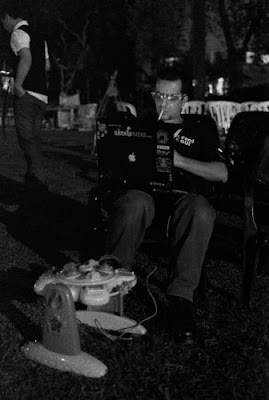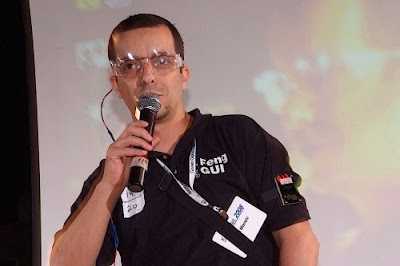By Rafael Mizrahi, Feng-GUI
KinnerNet Un-Convention is always a blast. and this year it was an explosion of geeks, technologies, art, food, humor … you name it.
I will not be able to describe (like last KinnerNet 2007 review I did with the blog WMMNA) in one small post, everything that happened this year. So, please accept my apologies, while I am only sharing my own contribution to this art-tech frenzy.
As an artificial vision explorer at Feng-GUI and a GarageGeeks member, I was invited to KinnerNet2008, and here is my contribution.
WiiMan SuperHero
http://wiimansuperhero.blogspot.com/

WiiMan and DR. Yossi Vardi
WiiMan the Super Hero is a full action figure costume of a super hero that functions as a Nintendo Wii remote.
Having trouble playing Wii? WiiMan to the rescue.
This project combines Gaming, Technology and Useless Activity to the extreme.
The GarageGeeks along with Yael Hertzog built this custom that acts as a fully functional Nintendo WiiMote remote with buttons, Bluetooth, accelerometers, and an IR cam.
Gadgethon
Under the category of Gadget I bought, I showed:
Wearable social bookmarking accessories made by Limor Fried, AKA Lady Ada,
Digg Button , MiniPOV
Under the category of Gadget I made myself, I showed:
* React-a-Baby - A collaborative electronic music instrument for babies


* iLed - Wearable party led lights glasses which flickers between 8-16 Hz and amplitude is based on a microphone input. Hallucinogen state of mind, not included.


KinnerNet Business Card
Hagai Cohen requested my programming skills creating a souvenir for KinnerNet 2008 participants. A business card with a stretched font that is readable only when you tilt the card.


Dove Shit Dove
The garagegeeks built a huge Dove that sense if someone is underneath it and crap a small spit of Dove soap on him. I helped with the sound effects.

MAKE /Face workshop
A workshop conducted by Michael Shiloh (MakingThings, MAKE magazine and OpenMoko) and Hanoch Piven (www.pivenworld.com) I built this Fakir’s hours made out of computer parts.

Skateboard Session
Oren Zuckerman from IDC Herzelia and MIT's Media Lab organized a spontaneous Skateboard session.
It turned into an old dogs session, of myself, Nir Ofir (BlogTV), Meir Brand (Google Israel GM), Ohad PressMan (3D3R) and Gary Shainberg (British Telecom CTO) on the SegWay














